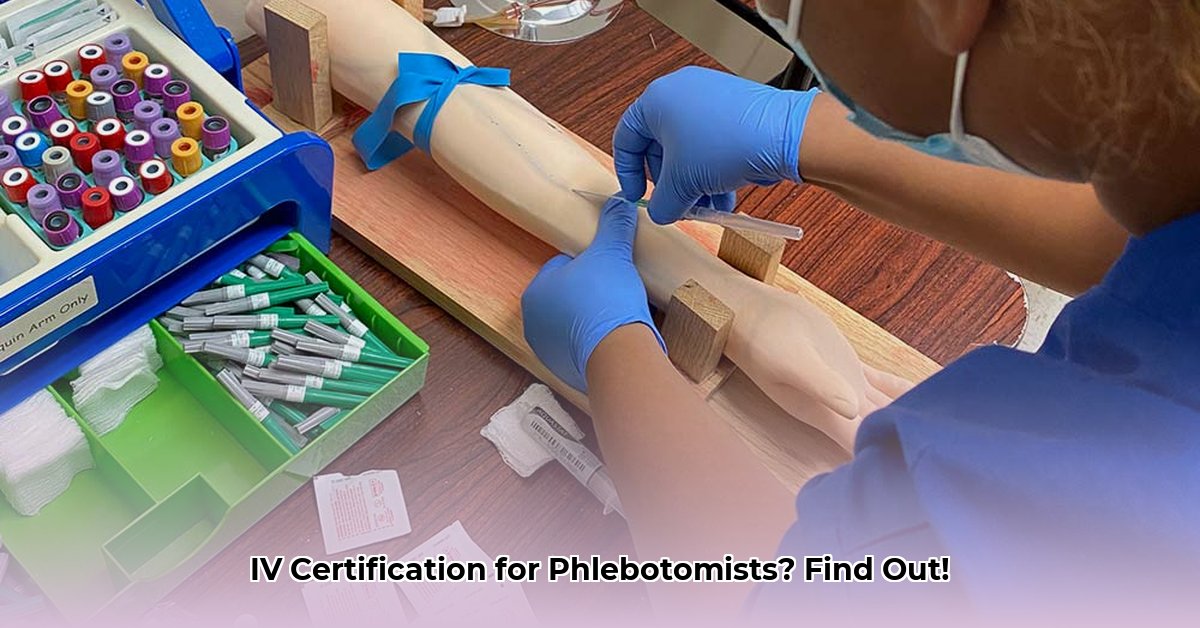
Can a Phlebotomist Get IV Certified?
The question of whether a phlebotomist can obtain IV certification is complex, with the answer depending heavily on individual state regulations. While phlebotomists possess expertise in locating veins—a crucial skill in intravenous (IV) therapy—the act of inserting an IV line requires additional training and often falls under the scope of practice for nurses or other licensed medical professionals. However, some states allow phlebotomists to pursue IV certification after completing specific training programs. This creates a varied landscape across the nation.
The Evolving World of IV Certification for Phlebotomists
The lack of national standardization for phlebotomist IV certification creates significant inconsistencies across states. Some states explicitly permit phlebotomists to obtain IV certification following completion of a state-approved training program; others prohibit the practice entirely. This inconsistency impacts both phlebotomists seeking career advancement and healthcare facilities seeking efficient staffing solutions. The potential for increased standardization and clarification of regulations is a topic of ongoing discussion within the healthcare community.
Your Path to IV Certification: A Step-by-Step Guide
If your state permits phlebotomists to become IV certified, here’s a structured approach:
Verify State Regulations: Begin by thoroughly researching your state's specific laws and regulations concerning phlebotomists administering IV therapy. Consult your state's board of nursing or equivalent regulatory body for definitive guidance. This is crucial to ensure compliance and avoid legal repercussions.
Locate Accredited Programs: Once you've confirmed the legal permissibility within your state, research accredited IV therapy training programs that adhere to all state requirements. Prioritize programs with strong reputations and significant hands-on training components.
Complete the Training Program: These programs typically deliver comprehensive instruction encompassing proper IV line insertion techniques, infection prevention protocols, essential safety procedures, and all other necessary aspects of safe and effective IV administration. Expect a blend of theoretical learning and supervised practical application.
Obtain Certification (If Applicable): Upon successful completion of the training program, you may receive a certificate, license, or other credential validating your competency in IV therapy. This credential will demonstrate your qualifications and adherence to relevant standards.
Maintain Ongoing Compliance: Remember that even with certification, you must consistently adhere to all applicable state, local, and national regulations, guidelines, and your employer's protocols concerning IV procedures. Maintaining compliance is paramount for the safety of your patients.
The Upsides and Downsides of Becoming IV Certified
Advantages of IV Certification:
- Enhanced Career Prospects: IV certification can unlock opportunities for higher-paying positions and career advancement within healthcare settings.
- Increased Skillset: This expanded skillset makes you a more versatile and valuable healthcare professional, in high demand in many clinics and hospitals.
- Improved Patient Care: In facilities experiencing staffing shortages or high patient volumes, your additional skills can translate to more efficient and timely patient care.
Disadvantages of IV Certification:
- Significant Time Commitment: The training process demands substantial time investment; it's not a short-term endeavor.
- Financial Investment: Completing an accredited program incurs expenses, including tuition fees and other related costs.
- Geographic Limitations: The legal permissibility and scope of practice for phlebotomists with IV certification vary significantly by location.
The Future of Phlebotomy and IV Therapy: A Possible Convergence?
The current inconsistencies in state regulations highlight a growing need for national standards concerning phlebotomist IV certification. Increased standardization promises to create clearer career paths for phlebotomists while simultaneously enhancing patient care through more consistent and broadly applicable training.
Actionable Intelligence: Guidance for Key Stakeholders
| Stakeholder | Short-Term Actions | Long-Term Goals |
|---|---|---|
| Phlebotomists | Research state regulations; identify and evaluate IV therapy training programs. | Advocate for national standardization; pursue continuous professional development. |
| Healthcare Facilities | Review staffing models and IV administration policies. | Invest in comprehensive IV therapy training; establish clear liability frameworks. |
| Regulatory Bodies | Conduct a thorough review of existing guidelines and explore collaboration with stakeholder groups. | Establish national standards for phlebotomist IV therapy training. |
How to Become a Phlebotomist Who Can Start IVs
Key Considerations:
- Specialized Training: Administering IVs necessitates specialized training beyond basic phlebotomy techniques.
- State-Specific Regulations: State laws vary significantly regarding the legal scope of phlebotomist IV administration.
- Legal and Ethical Responsibilities: Understanding and adhering to all legal and ethical considerations is essential, as improper IV insertion can lead to severe patient harm.
- Career Advancement: Pursuing IV certification can open pathways to enhanced career opportunities and responsibilities.
Understanding the Landscape: IVs and Phlebotomists
The ability of phlebotomists to administer IVs is a matter of state-specific laws and regulations. The procedures involved in IV line insertion are more complex than basic venipuncture, requiring detailed knowledge of anatomy, physiology, and sterile techniques to minimize risks of infection and other complications.
State-by-State Regulations: Navigating the Variances
To determine your eligibility for IV certification, it’s critical to consult your state's board of nursing or equivalent regulatory authority for precise information on current regulations. The allowed scope of practice for phlebotomists varies significantly from state to state.
Steps to IV Certification (Where Allowed)
If your state permits phlebotomists to administer IVs, the process typically involves:
- Researching Accredited Programs: Identify and research accredited IV therapy certification programs in your area.
- Completing the Program: Successfully complete a comprehensive IV therapy certification program designed to equip you with the theoretical knowledge and practical skills necessary for safe and effective IV administration.
- Passing the Certification Exam: Pass all required assessments and examinations to demonstrate competency in IV therapy.
- Compliance with Regulations: Maintain continuous adherence to all local, state, and national rules and guidelines governing IV therapy procedures.
Career Advancement and Specialized Training
Consider exploring further education options, such as becoming a Certified Medical Assistant (CMA), which may broaden your scope of practice to include IV insertion in states where regulations permit.
Risks and Responsibilities
Remember that the potential for medical complications from improper IV insertion is significant. Strict adherence to all training, protocols, and legal guidelines is non-negotiable. This meticulous attention to safety is paramount to protecting patient well-being.